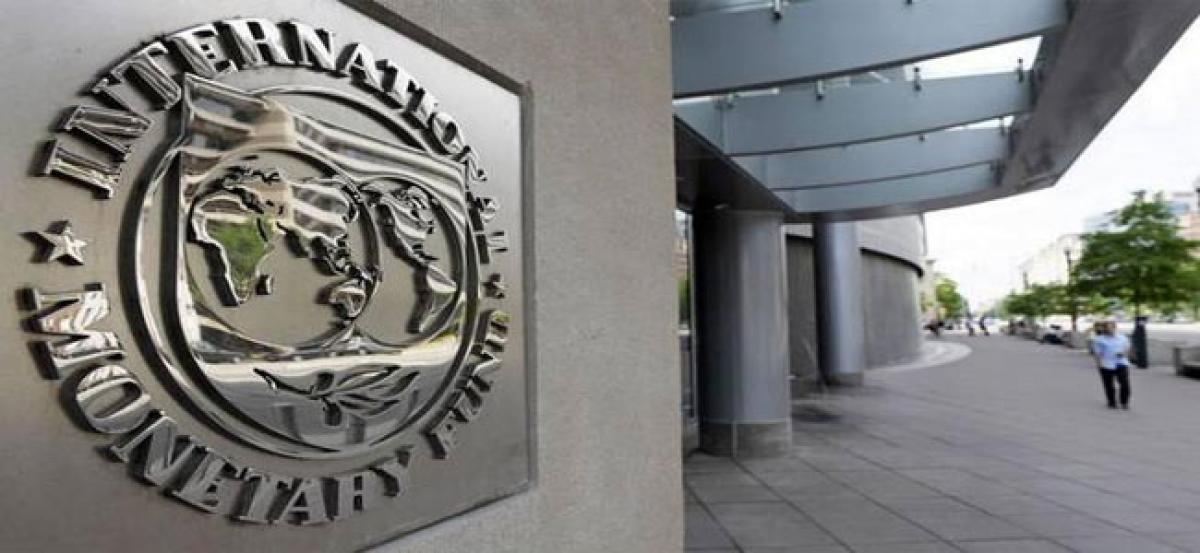Live
- Actor Suriya’s ‘Kanguva’ Leaks Online Hours After Theatrical Release
- Chandrababu's Andhra Pradesh Investment & Job Creation Plans (BN) for Industrial Growth
- Shankar’s daughter Aditi Shankar set to debut in Tollywood
- AR Rahman’s ‘Aadujeevitham’ Music Nominated Twice at 2024 Hollywood Awards
- NBK’s action drama ‘Daaku Maharaaj’ unveiled with power-packed teaser
- Nehru’s services unforgettable : Veerlapalli
- ROB ready by March-end
- 30.1-9-49-10 – Anshul Kamboj picks up all 10 wickets in Haryana vs Kerala Ranji Trophy match
- South Korean FM Cho, Blinken hold talks on margins of APEC summit in Peru
- India’s insurance sector growth surpasses China, Thailand: McKinsey
Just In

The Indian economy is expected to grow at 7.4 per cent in the current fiscal and accelerate further to 7.8 per cent as it recovers from the impact of demonetisation and Goods and Services Tax (GST) rollout, the International Monetary Fund (IMF) said on Wednesday.
Growth could accelerate further to 7.8% as the economy recovers from the impact of demonetisation and GST
The Indian economy is expected to grow at 7.4 per cent in the current fiscal and accelerate further to 7.8 per cent as it recovers from the impact of demonetisation and Goods and Services Tax (GST) rollout, the International Monetary Fund (IMF) said on Wednesday.
Asia continues to be the main engine of the world’s economy, accounting for more than 60 per cent of global growth - three-quarters of which comes from China and India alone, as per IMF’s Regional Economic Outlook: Asia and Pacific (REO).
“But there are risks and challenges ahead, including from a tightening of global financial conditions, a shift toward inward-looking policies, and - over the longer run - population aging, slowing productivity growth, and the rise of the digital economy,” it said.
Asia is expected to grow at 5.6 per cent this year and next, it said, adding that the outlook was supported by strong global demand, as well as still accommodative policies and financial conditions.
“In India, growth is forecast to rebound to 7.4 per cent in FY 2018/19 as the economy recovers from disruptions related to the currency exchange initiative and the rollout of the new Goods and Services Tax,” it said.
China, it said, was projected to grow at 6.6 per cent in the current year that will moderate to 6.4 per cent next year.
Explaining low inflation
Noting that present rates of inflation in Asia were some of the lowest in decades, it said, it had seen some upward movement since September 2017 on the back of rising oil prices.
“But core inflation - which excludes food and energy - remains low and below target in many economies. In 2017, headline inflation on average was 0.6 percent lower than target in Asian advanced economies, and 0.8 percent under target in Asian emerging market economies,” it said.
The latest report explores why inflation has been so low. And it finds that first that temporary global factors, including commodity prices and imported inflation, have been key drivers of low inflation. But these factors could reverse, and inflation could rise.
According to the report, inflation has become more backward-looking, meaning that past inflation drives current inflation more than future expectations. This suggests that if inflation rises, it may persist.
“Further, there is some evidence that the sensitivity of inflation to economic slack has decreased [i.e., the Phillips curve has flattened], suggesting that if inflation rises, there may be a large hit to output when reducing it,” it said.
All of these mean that central banks should watch out closely for signs of inflation pressure now and stand ready to respond.

© 2024 Hyderabad Media House Limited/The Hans India. All rights reserved. Powered by hocalwire.com







